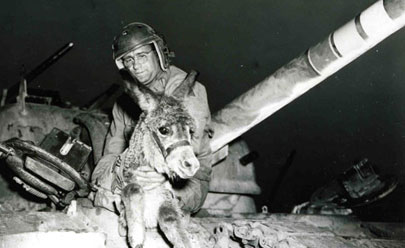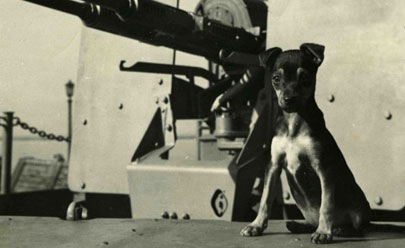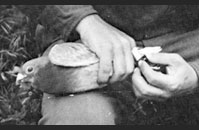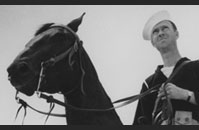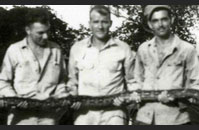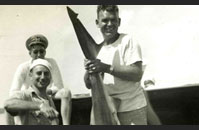FOCUS ON: LOYAL FORCES
Loyal Forces: The American Animals of World War II
At a time when every American was called upon to contribute to the war effort—whether by enlisting, buying bonds, or collecting scrap metal—the use of American animals during World War II further demonstrates the resourcefulness of the US military and the many sacrifices that led to the Allies’ victory.
From the last mounted cavalry charge of the US Army to the 36,000 homing pigeons deployed overseas, service animals made a significant impact on military operations during World War II. Every branch of the armed forces and every theater of the war utilized the instincts and dexterity of these dependable creatures, who, though not always in the direct line of enemy fire, had their lives put at risk for the jobs they performed.
Buy the Book

Through 157 photographs from The National WWII Museum collection, Loyal Forces: The American Animals of World War II captures the heroism, hard work and innate skills of innumerable animals that aided the military as they fought to protect, transport, communicate and sustain morale.
Get your copy of Loyal Forces: The American Animals of World War II.
Proceeds from the purchase of this item fund the continuing educational mission of the Museum in New Orleans.
Read Chapter One of Loyal Forces: The American Animals of World War II
Note: Only logged in, registered users of this site can view this content.
If you do not see a registration form here, that means you are logged in and can use the following link to download the sample chapter. Otherwise, quickly register above to access the information. If you are not logged in and you use this link, you will be told that the page cannot be found. If you are using Safari on Windows, the chapter may not appear; please use another browser.
Dogs and War
 Tech. Sgt. Floyd Harmon stands with a newly received war dog. Harmon was stationed at Fort Robinson, Nebraska, where he received dogs donated to Dogs for Defense.
Tech. Sgt. Floyd Harmon stands with a newly received war dog. Harmon was stationed at Fort Robinson, Nebraska, where he received dogs donated to Dogs for Defense.
 Military Policemen and dogs pose on part of the training course all dogs had to complete to become war dogs.
Military Policemen and dogs pose on part of the training course all dogs had to complete to become war dogs.
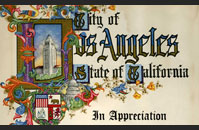 Certificate of Appreciation for Lady from Los Angeles, California, for her service as a war dog.
Certificate of Appreciation for Lady from Los Angeles, California, for her service as a war dog.
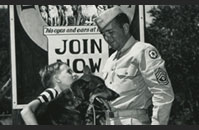 Clyde Porter gives his dog Junior to Dogs for Defense. Most of the United States’ 20,000 war dogs were volunteered for service by their owners.
Clyde Porter gives his dog Junior to Dogs for Defense. Most of the United States’ 20,000 war dogs were volunteered for service by their owners.
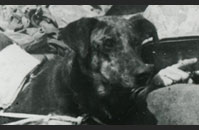 On Iwo Jima, Marine Cpl. Virgil Burgess instructs his messenger dog, “Prince.” Notice the special messenger pouch “Prince” wears to deliver messages. March 5, 1945.
On Iwo Jima, Marine Cpl. Virgil Burgess instructs his messenger dog, “Prince.” Notice the special messenger pouch “Prince” wears to deliver messages. March 5, 1945.
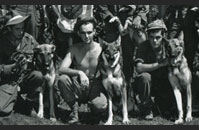 Scout dogs of the US Army’s Marauder Infantry pose with their handlers in Burma.
Scout dogs of the US Army’s Marauder Infantry pose with their handlers in Burma.
The Army Mule
Pigeons
Loyal Forces on the Home Front
Foreign Encounters
Pets and Mascots
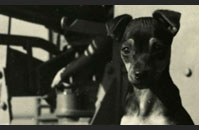 Snafu, a US Navy mascot.
Snafu, a US Navy mascot.
 Mascot of the escort carrier USS Bismarck Sea.
Mascot of the escort carrier USS Bismarck Sea.
 Mascot, with her puppy, of the 870th Aviation Engineering Battalion in Hollandia, New Guinea.
Mascot, with her puppy, of the 870th Aviation Engineering Battalion in Hollandia, New Guinea.
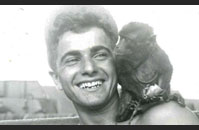 Monkey mascot of the US Navy’ Landing Craft Tank 1124.
Monkey mascot of the US Navy’ Landing Craft Tank 1124.
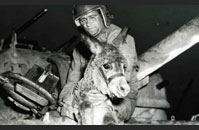 Colonel Sabodus, the mascot of an armored regiment in Italy.
Colonel Sabodus, the mascot of an armored regiment in Italy.
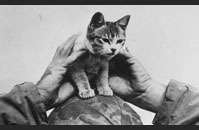 “Corporal Edward Burckhardt with kitten that he said ‘captured’ him at the base of Suribachi on the battlefield of Iwo Jima.”
“Corporal Edward Burckhardt with kitten that he said ‘captured’ him at the base of Suribachi on the battlefield of Iwo Jima.”
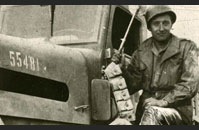 Technical Sgt. Howard R. Snyder with his truck. He and his rescue dog, Duchess, would often take cover under the truck when there was shelling or incoming fire. Africa 1944.
Technical Sgt. Howard R. Snyder with his truck. He and his rescue dog, Duchess, would often take cover under the truck when there was shelling or incoming fire. Africa 1944.


